A Hucknall History
Transport Back to the Future
Opening the first parish town passenger services October 1849 came from grouping a Derby based Midland Railway Company. They introduced tracks radiating from Nottingham. One heading northward through Ashfield connected Kirkby, before extending into Mansfield to next present a Sutton Junction station. That companies similar dated interest adopting and adapting a Huthwaite to Pinxton coal rail road only raised vague hope adding a village station platform, until a New Hucknall colliery diverted attention.
Huthwaite Railway Station
Interest here stems off another line claimed by Midland Railways. An Erewash Valley line had primarily targeted Derbyshire coal fields. Busy tracks headed on northward through Alfreton, from where the M&R laid an eastward Tibshelf & Teversal branch into Nottinghamshire. Crossing that border split off a Skegby branch skirting north Hucknall-under-Huthwaite boundaries, although its only purpose was collecting coals from a Whiteborough, Skegby and a future modernised Brierleyhill Colliery. Carving mapped path beneath Whiteborough fields and their Hopkin Lane bridge left lines terminating close the Miners Arms in Stanton Hill.

Woodend Station
Routing profitable industrial railroads usually rewarded affected communities with addition of a station platform. Ploughing through lower valley beneath Huthwaite heights gained just one roadside placement. Dated 1st May 1886 opening for an initial Woodend
parcel station recognised remote Wood End area addressing claimed by a few farm cottages overlooking railway developments.
Listing locally connected stations from 1891 Midland Railways timetable identifies Pye Bridge, Alfreton, Westhouses and Blackwell, Tibshelf and Newton, Woodend (for Hucknall Huthwaite), Teversall, Pleasley, Chesterfield, Mansfield and Mansfield Woodhouse. Links to city destinations of St Pancras London, Sheffield and Derby would join up other independently networked destinations.
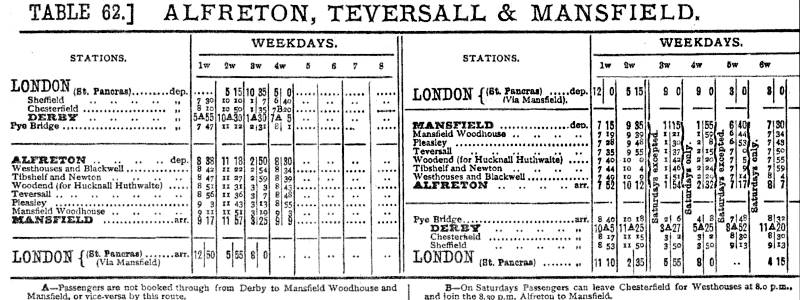
Thanks to specialist researcher Mr Glynn Waite for sharing his published subject article in the Midland Railway Society Journal. He adds further detailing, plus a marvellous rare photo shared from the Andrew Knighton collection. Station renaming begins after just five months from opening. A fuller titled Woodend for Hucknall Huthwaite
must timely reflect upgrade from just freight into fullest passenger service, while clearly emphasising it was primarily designed to support this then fast emerging township population.
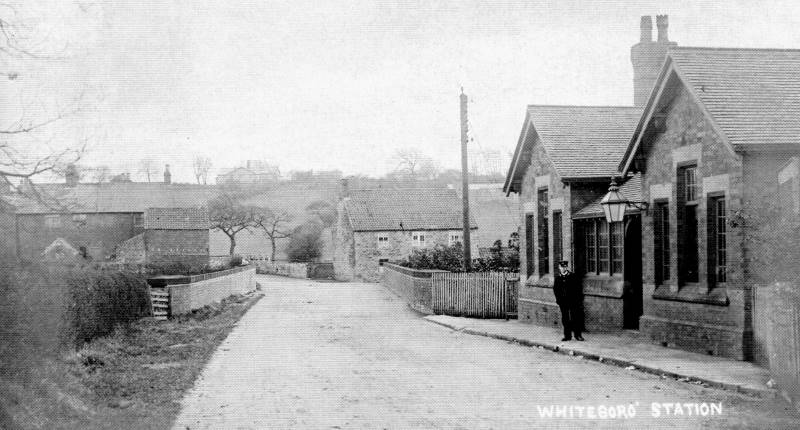
The Sutton Local Board Highway Committee had reportedly recommended back in January an application be made to the county authorities for the road from Hucknall Huthwaite to the railway station to be made a main road.
A fabulous view of the Huthwaite ticket office faces furthest end that thereafter addressed Station Road. A clue revealing actual year taken defies far earlier disuse.
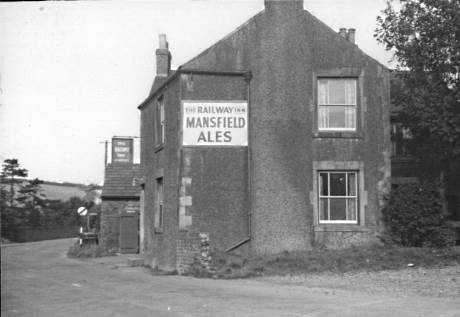
The originally addressed Woodend farm at Wood End was likely built by Stephen Ashmore around same time laying the railroad. His short lived 1871 listed title of beer house keeper left his wife in charge her 1881 signed Railway Inn. She'd therefore witness later construction of Woodend Station, but little extra custom.
Family owned pub continued serving Tibshelf miners homed in their Railway Inn Yard cottages. Hearing just a few very dubious voiced claims having once travelled from the later Whiteborough Station, only emphasises the imagination of eager story tellers. Commonest understanding was it barely attracted passengers, especially throughout latter years. Records best confirm that.
Being situated only about a half mile walk from populated core seemed quite accommodating. But Station Road has a steeper gradient over Strawberry Bank heights, so horse drawn wagons might struggle collecting heavier cargo. And if carriers could be hired for easily sending off luggage carrying passengers, there was no taxi rank facilitating any homeward burdened travellers.
 Mr Waite recognised how this stations layout proved unique by spanning two counties. Passengers entering from Nottinghamshire stepped down onto the lower platform which stretched across into Derbyshire. An old Newton Wood edged that boundary, which lent previous remote area naming for Wood End.
Mr Waite recognised how this stations layout proved unique by spanning two counties. Passengers entering from Nottinghamshire stepped down onto the lower platform which stretched across into Derbyshire. An old Newton Wood edged that boundary, which lent previous remote area naming for Wood End.
I cannot, however, offer any definitive answer to how a cluster of nearby farm dwellings managed to hold grander address as a City of Whiteborough
. Of course there have been a number of theories suggested, although none can be taken seriously. Strongest beliefs relate this railroad had potential to feed planned growth. Tracing name back a few centuries kindly dismisses notion.
Whiteboro' Station
This station changed name nearly as many times the Hucknall-under-Huthwaite township it was clearly meant to serve.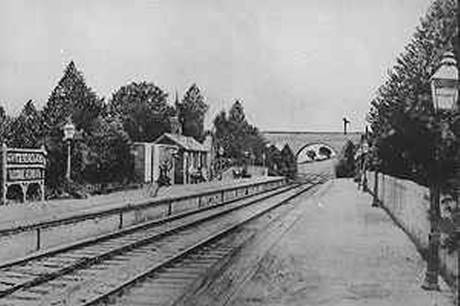 Rail side photo displays platform waiting room signed next
Rail side photo displays platform waiting room signed next Whiteborough for Hucknall Huthwaite
. That renaming is given official dating from 20th January 1893.
Swapping Woodend for Whiteborough did at least keep Hucknall Huthwaite in the title. It would advertise primary destination, mainly for the benefit of family arrivals seek work at New Hucknall Colliery. Area addressing of Woodend would not be broadly identifiable, whereas a mapped Whiteborough had more claim to the name running tracks through its lower meadows beyond its small colliery. But there isn't any known logical reason for the M&R choice of changing titles, especially after earliest closures of that coal pit.
The Huthwaite sited booking office entrance set aside the Station Road bridge becomes finally retitled into serving a future named Whiteboro' Station
, from a confirmed date 1st January 1908.
From Named Starting pa Transferred From Transferred Onto
1887 Benjamin Pointer £63.14 Signalman Bulwell Station Master Wryde
1888 Samuel Eaton £63.14 Booking Clerk Sutton Station Master Hathern
1892 Obadiah J Haddock £63.14 Station Master Langwathby Resigned
1898 Harry York £65.00 Signalman Cudworth Station Master Attercliffe Rd
1902 Herbert T Bunker £70.00 Porter King's Norton Station Master Stretton
1906 V H Owen £80.00 Station Master Stretton exchanged with HJ Bunker
1907 H C Bryant £80.00 Goods Clerk Langley Mill Station Master Kimberley?
Post withdrawn beyond 1908, placing duties lastly under Teversal Station Masters
1911 James King - 1915 W R Pumfrey - 1921 Thomas Tongue - 1922 Mr Cornell
Relevant extracts from authoritatively compiled fuller listing presents titled role of Station Master throughout those initial three decades. Beyond 1908 however, that post was withdrawn to place duties under the Teversal Station Masters charge.
A number of contributing factors influenced that timely change. Rapid residential expansion had shifted the populated hub in an easterly direction away its own Huthwaite Station. It was left remotely stood without much passing traffic on a future named Chesterfield Road, so the towns busy terminus also changed sign reflecting how the Great Northern platform already competitively advertised Sutton-in-Ashfield for Huthwaite
. Carters had maintained the main transportation route anciently tying Huthwaite with Mansfield along the Sutton highway. Their demise was similarly recognised following 1906 introduction of regular electric trams affording commutes.
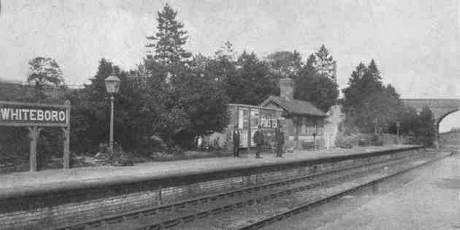
Opening a huge 1907 CWS factory highlighted this stations disadvantaged location about 1.2 miles distant. Needing to transport larger quantities by train still relied on horse drawn carts ferrying heavy loads to and from its factory warehouse. Choice between two almost equally distant railed goods platforms had to favour Sutton. It measured just a fraction further away, although in easier reach because a well established highway followed a far less demanding gradient. Huthwaite Urban District Councillors heard their request and did agree need for a closer station. They tried inducing the Great Central Railway into extending their popular line.
 Proposing a centralised Huthwaite passenger platform with direct connection between both Sutton and South Normanton came before 1909 plans to again extend the New Hucknall Colliery Branch line next joining into Whiteborough station. Adding a pit side passenger platform off Common Road also appears to have been suggested. Negotiations failed to persuade the Railway Boards.
Proposing a centralised Huthwaite passenger platform with direct connection between both Sutton and South Normanton came before 1909 plans to again extend the New Hucknall Colliery Branch line next joining into Whiteborough station. Adding a pit side passenger platform off Common Road also appears to have been suggested. Negotiations failed to persuade the Railway Boards.

Midland Railway had obligingly erected local stations after winning profitable coal haulage routes. There was little profit here hauling passenger carriages for the novelty of occasional group outings. Brierley Sutton Colliery in Stanton Hill had to make do with existing town platforms, although a remoter Teversal mining community had a closer station worthier of more frequent daily use.
Merging the 1923 Midland Railway into a superior sized London, Midland and Scottish Railway results in the September 1924 timetable removing one of a revolving four train journeys forwarding an earlier evening finish. Cost cutting measures had to eventually show inefficiency keeping any underused station.
Given date marking official withdrawal of both passenger and goods services from Whiteborough Station is 4th October 1926. Those other stations clung onto a single daily train service until 28th July 1930 mass closures. Internal combustion engines had proven the next revolutionary power, and greater flexibility ended another era by making electric trams obsolete two years on.
Belying such early dated closure of Whiteboro' Station is that magnificent scene of a tidily kept booking office fronted by a smartly uniformed railway employee. Extensive village research can assure any railway enthusiast year taken must be 1933/4, because its doubly unique in exposing that short term siting of a precautionary prefab isolation hospital called The Woodlands
. Closing 1924 public services therefore obviously didn't mean the structure had been totally vacated. Whether a signalman was ever needed or retained to switch points between the two branch lines, or a caretaker kept simpler watch over the place can only be pondered. To question how and why it was kept years beyond mass closures needs answers beyond my research limitations. I will nonetheless, hazard a guess on that photo being specifically staged with timely intention to present a final record just before ultimate demolition.
Final reclamation of overgrown stone platforms left a fully cleared site to nature. Our family rambles partly on this railroad collecting wild blackberries, were safely between diesel locomotives still hauling laden trucks. Sutton Colliery 1989 closure finally ended use. Stepping way through 2002 entangled overgrowth randomly encountered a few old wooden sleepers and rusty rails. Views of and off the still currently used road brick built Woodend Bridge, has to be most solid reminder left to a bygone era powered by steam.
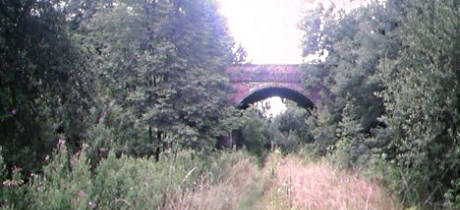

Industrial heritage featured when planting a Brierley Forest Park. Adding a later surfaced cycle trail led under the rail bridge. The old Railway Inn incidentally, had no railway company connections. Its yard cottages might just have added one or two redundantly sold Whiteborough railway carriages, as shown likewise affording a Hancock family 95 Chesterfield Road address. Yard clearances exposed large grounds. Ironic a 1980s car park finally accommodated passing custom when welcoming start up of a pub carvery.
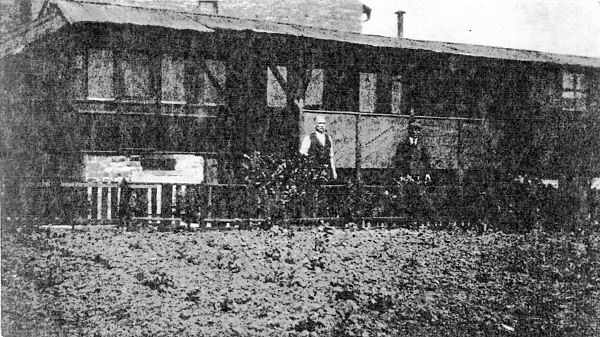
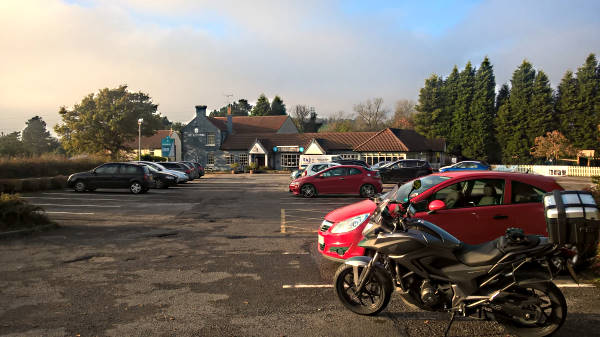
26 Feb 04 by Gary Elliott Updated 06 Feb 23
